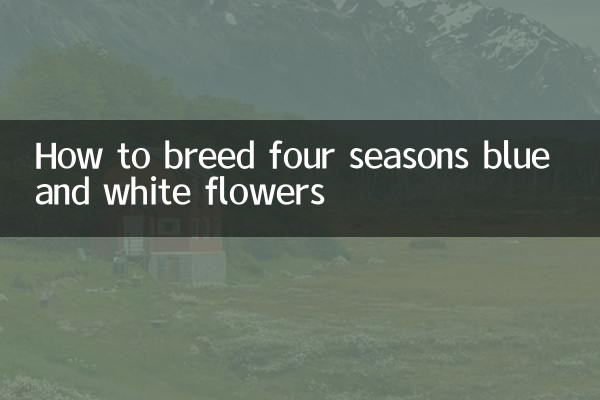How to breed four seasons blue and white flowers
Blue and white flowers are a highly ornamental plant that is loved by florists for its evergreen color and bright flowers. If you want to raise four-season blue flowers, you need to understand their growth habits and maintenance points. The following is a detailed guide on the cultivation of four-season blue flowers, including soil, light, watering, fertilization and other key contents.
1. Basic information about Four Seasons Blue and White

The scientific name of Four Seasons Blue and White isLiriope muscari, also known as Ophiopogon japonicus, is a perennial herbaceous plant of the genus Ophiopogon japonicus in the Liliaceae family. Its leaves are slender and evergreen all year round. The flowering period is usually from summer to autumn. The flower colors are mainly purple and white. It is suitable for planting in courtyards, flower beds or potted plants.
| Properties | Description |
|---|---|
| scientific name | Liriope muscari |
| Family | Ophiopogon japonicus |
| flowering period | summer to autumn |
| Color | purple, white |
| suitable temperature | 15-25℃ |
2. How to breed four-season blue and white flowers
1. Soil selection
Four seasons blue and white flowers do not have high soil requirements, but loose, well-drained sandy loam is preferred. When potting, you can use leaf humus soil, garden soil and river sand mixed in a ratio of 1:1:1 to ensure air permeability and water retention.
| soil type | Proportion recommendations |
|---|---|
| humus soil | 1 serving |
| garden soil | 1 serving |
| river sand | 1 serving |
2. Lighting requirements
All-season blue and white flowers prefer a semi-shady environment and are highly tolerant of shade, but long-term lack of light will cause the leaves to turn yellow. It is recommended to place it in a place with sufficient scattered light and avoid direct sunlight in summer.
3. Watering management
All-season blue and white flowers like a humid environment, but are not tolerant of stagnant water. Keep the soil slightly moist during the growing season and reduce watering frequency in winter. When watering, pay attention to "seeing dry and seeing wet" to avoid excessive moisture in the pot soil, which may lead to root rot.
| season | Watering frequency |
|---|---|
| spring | 2-3 times a week |
| summer | 3-4 times a week |
| autumn | 2 times a week |
| winter | 1 time a week |
4. Fertilizer tips
Four-season blue flowers have moderate fertilizer requirements, and thin liquid fertilizer can be applied once a month during the growth period. Add phosphorus and potassium fertilizer before the flowering period to promote flowering. Stop fertilizing in winter.
| Fertilizer type | Frequency of use |
|---|---|
| Thin liquid fertilizer | 1 time per month |
| Phosphorus and potassium fertilizer | 1-2 times before flowering period |
5. Reproduction methods
Four seasons blue and white flowers can be propagated by division or sowing. The division method is simple and easy. In spring and autumn, separate the mother plants and bring 2-3 buds to each plant. Sowing and propagation need to be carried out in spring, and the germination rate is low.
3. Common problems and solutions
1. Leaves turn yellow
Possible causes: Insufficient light, overwatering or poor nutrition. Solution: Adjust light conditions, control watering frequency, and add fertilizer appropriately.
2. No flowers
Possible reasons: Insufficient light or lack of phosphorus and potassium fertilizers. Solution: Increase scattered light and add phosphorus and potassium fertilizer before the flowering period.
3. Pest and disease control
Four seasons blue and white flowers are less likely to suffer from diseases and insect pests, and occasionally there will be aphids or red spiders. When you find an insect infestation, spray the leaves with soapy water or insecticide.
4. Summary
Green flowers are an easy-to-maintain ornamental plant. As long as you master the basics of soil, light, watering and fertilization, you can make it grow healthily and bloom. Whether planted in the garden or in pots, four-season blue flowers can add a touch of greenery to the environment.

check the details

check the details